Abstract
Full-duplex (FD) radios can transmit and receive packets simultaneously in the same frequency band. Although this potentially doubles the spectral efficiency, it also causes inter-node interference, which was not an issue for half-duplex (HD) radios and can significantly reduce FD radio throughput. This paper proposes a hybrid transmission switching algorithm to reduce performance degradation due to inter-node interference. In contrast to previous studies that only considered channel capacity, we determine the transmission mode by considering the modulation and coding scheme (MCS). The access point compares the required transmission time for HD, FD, and hybrid mode and selects the mode with the best network throughput. We also designed an analytical model to evaluate network throughput for the proposed algorithm. In particular, we consider FD pair probability, which has not been addressed previously. Analytical and simulation results verify that the proposed algorithm improves network performance.
1. Introduction
Full-duplex (FD) radios can improve spectral efficiency by simultaneously transmitting and receiving packets in the same frequency band. In contrast, half-duplex (HD) radios do not support concurrent transmission and reception in the same frequency band due to self-interference (SI). However, FD radios have become feasible with self-interference cancellation (SIC) developments. SIC eliminates SI at 110 dB, achieving the same signal level as the noise floor [1,2,3].
In principle, FD radios can double the spectral efficiency by transmitting and receiving simultaneously. They were not adopted as the 5G standard, and hence, FD interest has faded somewhat. However, researchers have paid attention to FD radios as 5G standards were recently defined and beyond 5G and 6G began to be studied to improve the spectral efficiency [4]. Furthermore, a new task group, IEEE 802.11 TGbe, was established to investigate higher throughput and lower latency, which considered the FD technical interest group (TIG) as a candidate technology for IEEE 802.11 TGbe [5].
FD pairs must be established to fully utilize FD radios. There are two FD pair types: symmetric and asymmetric. Symmetric FD pairs use a node and access point (AP) to transmit and receive packets between each other; whereas the uplink (UL) node transmits a packet to the AP, and the AP transmits a packet to the downlink (DL) node for asymmetric FD pairs. Thus, an asymmetric FD pair can be established even when only the AP has FD capability. However, inter-node interference occurs because the UL and DL nodes are different, which reduces spectral efficiency. Asymmetric UL/DL transmission time is also a problem, leading to unused link periods. A busy tone is typically used during this unused link period to avoid the hidden node problem. However, the busy tone also reduces spectral efficiency since it does not contain data.
Several FD medium access control (MAC) protocols to support an asymmetric FD pair have been proposed [6,7,8]. They collect the SIRinformation to prevent transmission failure due to inter-node interference and establish the FD pair based on this information. The successive full duplex link setup (SFLS) was proposed in [9]. The AP collects the buffer state information to support successive FD transmission. It reduces the overhead due to channel competition, which improves throughput.
In [10,11], distributed scheduling algorithms were proposed. Chen et al. [10] proposed the hybrid greedy maximal scheduling (H-GMS) algorithm. It guarantees the maximum throughput in the network where both the FD and HD nodes exist. Ren et al. [11] proposed a reinforcement learning approach to learn the best link to activate and set a data rate.
The performance analysis of networks with multiple APs has also been studied [12,13]. Lee and Tony [12] presented how to determine the portion of FD mode APs to maximize throughput. Liu et al. [13] proposed the ellipse interference and carrier-sensing models to prevent the hidden node problem.
A few types of research have been made to utilize the unused link period [14,15,16,17]. Murad and Eltawil [14] proposed the frame aggregation scheme to reduce the unused link period. Kim et al. [15] proposed an FD MAC protocol that allows packet transmission during the unused link period. When the unused link periods occur, the node that wins the channel competition transmits a packet. Alim et al. [16] proposed the Asym-FDMAC protocol, which supports multiple UL transmissions during the unused link period. In contrast to the FD MACprotocol [15], the AP schedules packet transmission; hence, there is an information collection period for each transmission cycle. Ahn and Shu [17] proposed the FD MAC protocol, which sends a buffer status report during unused uplink periods (BRUs), comprised of contention and scheduling periods. Each node transmits an acknowledgment (ACK) packet containing hidden node and buffer state information. The AP schedules packet transmission based on this information and collects hidden node and buffer state information for each node to establish FD pairs. It then schedules packet transmission based on the collected information.
This paper proposes a hybrid transmission switching algorithm that selects the transmission mode considering the wireless channel environment. Most previous studies focused on utilizing the unused link period, whereas the proposed approach focuses on improving network throughput even with unused link periods. The AP collects signal-to-interference ratio (SIR) information for each node and selects the transmission mode that provides better throughput. Switching between HD and FD was considered previously [12,18,19]. Most conventional studies selected the transmission mode based on channel capacity to maximize the instantaneous data rate. This is an appropriate method in terms of link level, but not in terms of network level. Channel capacity cannot be fully utilized since the data rate is determined by the modulation and coding scheme (MCS) level. Overheads also occur due to data transmission procedures, such as request to send/clear to send (RTS/CTS) and ACK packets. Therefore, the proposed algorithm selects the transmission mode based on the MCS level.
We designed an analytical model considering FD pair probability. FD transmission is impossible if an FD pair is not established. Therefore, FD pair probability should be considered to assess FD radio network performance. However, FD pair probability has not been addressed in previous studies, which assumed a fixed probability and analyzed network performance. Therefore, we first computed FD pair probability based on the MCS level to improve analysis accuracy. We subsequently designed an analytical model that considers FD pair probability. The contributions of this paper can be summarized as follows.
- Hybrid transmission switching algorithm: We propose a new criterion for selecting the transmission mode. The AP selects the transmission mode according to the MCS level rather than the channel capacity. The proposed algorithm focuses on improving network throughput even with unused link periods, significantly improving network throughput.
- Analytical model for hybrid transmission: FD pair probability should be analyzed first to adequately evaluate network performance. Most previous studies have paid little attention to FD pair probability. In contrast, we explicitly consider FD pair probability in the analytical model to improve model accuracy. Simulation results verify the proposed analytical model’s accuracy.
The remainder of this paper is organized as follows. Section 2 introduces the proposed system model. Section 3 describes the proposed hybrid transmission switching algorithm procedure. Section 4 details the analytical model for the proposed algorithm, and Section 5 verifies the proposed algorithm’s accuracy through simulation. Finally, Section 6 summarizes and concludes the paper.
2. System Model
We consider an infrastructure mode wireless local area network (WLAN) system based on carrier sensing multiple access/collision avoidance (CSMA/CA). Figure 1 shows the considered system model, assuming one AP with N nodes randomly distributed within the AP’s coverage. We also assume that only the AP operates in FD mode to allow for backward compatibility and co-dependence with existing 802.11 devices. Thus, only asymmetric FD pairs can be established. To establish an FD pair, the AP must be aware of the SIR information for each node. The AP can measure the SIR for the UL () directly. However, measuring the SIR value experienced by each node () requires two values: the AP’s signal strength and the other node’s interference strength. Therefore, each node measures and informs the AP through the RTS/CTS exchange procedure [6,8]. When a UL node accesses a channel, it transmits the RTS packet to the AP. The nodes that receive this RTS packet measure the interference strength. The AP then replies with the CTS packet to the UL node. Similarly, the nodes that receive this CTS packet measure the signal strength. Because the CTS packet contains the address of the UL node, the nodes know the UL node that transmitted the RTS packet. Each node can calculate the SIR value through two measured signal strengths. The nodes accessing the channel then inform the AP of the SIR information via the RTS packet. The FD pair can be established when and exceed the SIR threshold (). The corresponding area is referred to as the FD region, which can be divided into several MCS regions according to SIR. The region where hybrid transmission is possible in the FD region is called the hybrid region. The channel model considers the Rayleigh fading model. The power of the received signal is exponentially distributed with a probability density function (PDF):
where P is the average power of the received signal. In terms of decibels, P is calculated as follows:
where is the transmission power, G is the antenna gain, is the path loss with distance d, d is the distance between the transmitter and receiver, and is the signal wavelength. We evaluated network throughput, which reflects the long-term channel properties. Thus, the analytical model considers the ergodic received signal power. Therefore, UL and DL SIR can be calculated as follows:
where and are AP and node transmission power, respectively; and are the AP and node antenna gain, respectively; is the residual self-interference; is the distance between the AP and UL node; is the distance between the AP and DL node; and is the distance between the UL and DL nodes.
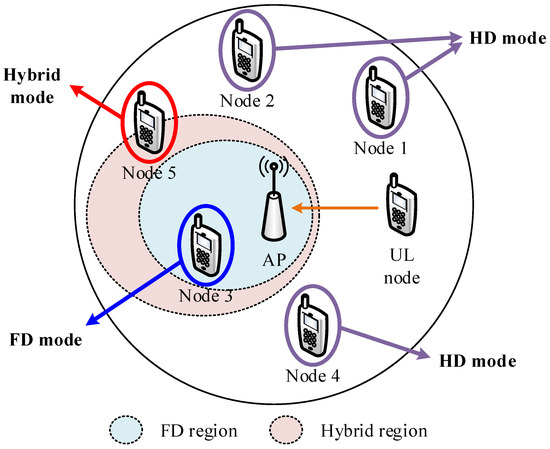
Figure 1.
System model.
3. Proposed Algorithm
In the proposed algorithm, the AP operates in three modes: HD, FD, and hybrid. The AP and node determine the MCS levels depending on SIR when transmitting a packet. There are no SI and inter-node interference when the AP operates in HD mode. Therefore, the UL or DL packets can be transmitted to the higher MCS level. However, an additional channel competition is required to transmit both the UL and DL packets as shown in Figure 2a.
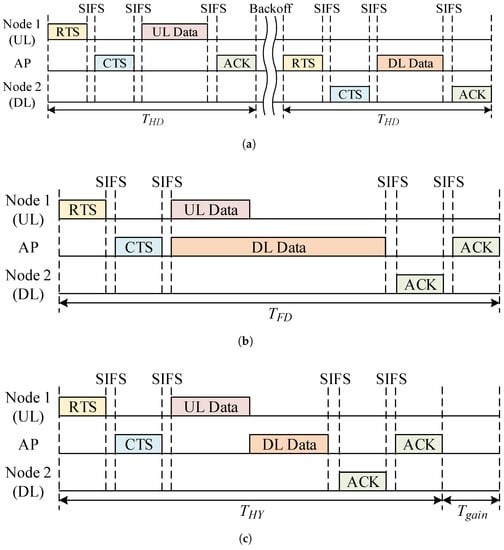
Figure 2.
Examples of (a) HD transmission, (b) FD transmission, and (c) hybrid transmission. RTS, request to send; CTS, clear to send; SIFS, short inter-frame space.
The asymmetric FD pair transmission signal from the UL node interferes with the DL node, reducing DL channel capacity, and the AP transmits a packet to the lower MCS level. Although the same size packets are transmitted, the UL and DL transmission times differ, as shown in Figure 2b. The UL node has to wait until the DL transmission completes to receive the ACK. Thus, network throughput is degraded due to unused link periods. Previous studies have proposed algorithms to utilize this period. Throughput can be improved by transmitting UL data packets during the unused link period. However, the DL data packet can also be transmitted to higher MCS levels if UL and DL data packets are transmitted separately. Thus, the total transmission time can be reduced, as shown in Figure 2c. All nodes, including the AP, conduct channel estimation over the preamble in the IEEE 802.11 distributed coordination function (DCF). This allows a hybrid transmission without additional procedures for collecting signal-to-noise ratio (SNR) information. Therefore, we propose a hybrid transmission switching algorithm to improve network throughput, focusing on reducing the total transmission time. Since the AP has SIR information for each node, it is possible to calculate the required transmission time. The required transmission time can be expressed as follows:
where and are the RTS and CTS time, respectively; and are the UL and DL transmission time, respectively; is the ACK time; and is the short inter-frame space (SIFS) time.
FD pairs are impossible when the AP wins the channel competition because only the AP has FD capability in the considered system model. Thus, the proposed algorithm can be applied when a node wins the channel competition. If node i wins the channel competition, it becomes the UL node and transmits RTS to the AP. Since the AP transmits the DL data packet in its own buffer, the DL node is already determined. The AP checks that it is possible to establish the FD pair with the DL node, which depends on UL and DL SIR. The FD pair is impossible if either is weaker than the SIR threshold or the buffer of the AP is empty. In this case, the AP operates in HD mode. The AP may not have DL SIR information because it requires time to collect SIR information. Even in this case, the FD pair is impossible, and the AP operates in HD mode. In contrast, if the FD pair can be established, the AP determines the FD and hybrid transmission MCS levels based on their SIR. It then calculates the required transmission times for each transmission mode and selects the transmission mode with the shortest transmission time. The required transmission time is included in the duration field of the CTS packet. The UL node that received the CTS packet modifies the ACK timeout. The AP conducts a procedure for selecting the transmission mode upon receiving the RTS packet and determines the transmission mode within the SIFS interval. The detailed procedure is shown in Algorithm 1.
| Algorithm 1 Hybrid transmission switching algorithm. |
Require: Node i that wins the channel competition
|
4. Performance Analysis
This section describes the proposed analytical model. To establish FD pairs, must exceed the SIR threshold. UL transmission is subject to residual SI. If SI is insufficiently eliminated, the AP can only establish an FD pair with the UL node located near the AP. Therefore, the condition is given by:
where = +, is the SIR threshold with MCS level m, and is the maximum that satisfies this condition. We assume that nodes are randomly distributed within the AP’s coverage. Therefore, the PDF is given by:
where r is the AP coverage radius.
Since the DL node is subject to inter-node interference, DL transmission MCS is determined by . The MCS region is the area where FD pairs can be established, i.e., the AP can only establish FD pairs with nodes located in the MCS region. Thus, the MCS region is where exceeds the SIR threshold for the corresponding MCS. This condition can be expressed as follows:
where .
If the AP, UL, and DL nodes are located at (0,0), (,0), and (,), respectively, and can be expressed as follows:
hence, the condition for establishing the FD pair is as follows:
A higher MCS level implies a higher SIR threshold to support a higher data rate, which reduces the MCS region. Thus, FD pair probability with MCS level m is the probability that the DL node is located in the corresponding MCS area, which can be computed as the ratio of the MCS region to AP coverage. The conditional probability that the DL node is located in each MCS region when the UL node is located at (,0), , can be expressed as follows:
where is the integral area where the DL node is located in each MCS region. The FD pair probability with MCS level m, , can be expressed as follows:
The AP operates in hybrid mode when the transmission time is shorter than FD mode (i.e., > 0). Therefore, the probabilities for hybrid and FD modes are as follows:
Saturation Throughput
This paper considers the saturation traffic model, i.e., the AP and all nodes always have packets to transmit. We adopt the Markov model from [20], which analyzed 802.11 DCF performance, to analyze saturation throughput for the proposed algorithm. However, this model needs to be modified because FD communication has not been considered. The major difference from our analytical model is the FD pair probability.
The binary exponential backoff (BEB) algorithm is applied for practical WLAN systems. All nodes, including the AP, generate a random number within the contention window as their backoff counter. The contention window size is doubled if the nodes fail to transmit a packet. The backoff counter reduces when the channel remains idle for one slot time. Nodes can attempt to transmit a packet when their backoff counters reach zero. The probability that a node attempts to transmit in slot, , can be expressed as follows:
where W is the minimum contention window size, p is conditional collision probability, and k is the maximum backoff stage. Conditional collision probability, p, is given by:
where N is the number of nodes. The channel state is changed to busy when any node attempts to transmit a packet. The probability that a channel is busy, , can be expressed as follows:
For successful transmission, only one node should attempt to transmit, while the other nodes keep silent. Thus, the probabilities that the AP and node transmit a packet successfully are, respectively,
Collision probability is given by:
The collision time, , is calculated as:
where is one time slot (i.e., duration of one back-off counter). Finally, throughput, S, can be computed as follows:
where:
is HD mode probability, and is the average payload size.
5. Performance Evaluation
This section evaluates the proposed algorithm’s performance using numerical analysis and MATLAB simulations with simulation parameters as shown in Table 1 [21]. We assumed MCS = 2–6, and Table 2 shows the data rate and SIR threshold with respect to the MCS level. The SIR threshold was measured for the FD pair [22]. Although the ergodic value was used in the analytical model, Rayleigh fading was applied for the simulation. We assumed that all nodes, including the AP, always have data to transmit. The nodes are randomly distributed within the AP coverage, and there is no mobility. The radius of the AP coverage is set to 20 m. The simulation is conducted 1000 times for each scenario, and a 95% confidence interval is used. We included the BRU [17], X-duplex (XD) [19], and HD to evaluate throughput and delay. Comparative results for previous studies are as follows.

Table 1.
Simulation parameters.

Table 2.
Data rate and SIRthreshold with respect to the MCS level.
- Proposed: The proposed algorithm determines the transmission mode from the required transmission time. Considering unused link periods, the AP selects the transmission mode with the shortest required transmission time.
- BRU: Each node transmits buffer state information to the AP during the unused link period. The AP uses the reported information to provide transmission opportunities to nodes without contention.
- XD: XD proposes hybrid switching transmission by dynamically configuring the antenna mode to maximize the instantaneous sum rate. Thus, MAC protocol overheads were not considered.
- HD: HD is the traditional IEEE 802.11 DCF. All nodes, including the AP, operate in HD mode. HD is based on CSMA/CA with the BEB algorithm [21].
We summarize the comparison of the FD MAC protocols in Table 3.

Table 3.
Comparison of FD MAC protocols. XD, X-duplex.
5.1. Results Based on the Number of Nodes
Figure 3 shows UL and DL network throughput with respect to the number of nodes. Nodes can transmit packets with a high data rate in HD because there is no SI. Thus, HD UL throughput exceeds that for FD schemes, e.g., proposed, BRU, and XD. In contrast, HD DL has the lowest throughput since the AP can transmit a packet in FD even if a node accesses the channel, whereas DL transmission only occurs in HD when the AP accesses the channel.
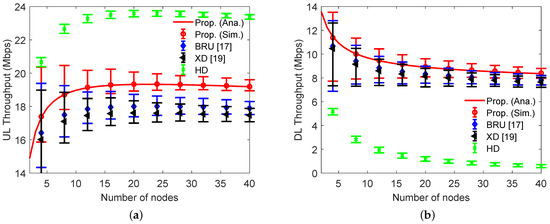
Figure 3.
Throughput based on the number of nodes (self-interference cancellation (SIC) = 110 dB) for (a) UL and (b) DL.
Figure 4 shows UL and DL network delay with respect to the number of nodes. We defined the interval between successful transmissions as the delay, thus from the time the previous ACK was received to the time the next ACK was received. The delay consists of the period that competes for channel access (back-off) and the required transmission time according to the mode of transmission. The probability for each node accessing the channel reduces as the number of nodes increases. Collision probability also increases, which increases UL delay. HD UL delay without SI is the shortest because the UL data packet can be transmitted to a higher MCS level. DL transmission in HD only occurs when the AP accesses the channel. The probability that the AP accesses the channel is , and hence, HD DL delay increases linearly with the number of nodes. In contrast, DL transmission in FD is possible if an FD pair is established. The FD scheme DL delay does not change significantly with an increasing number of nodes.
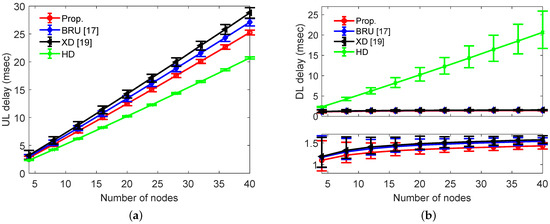
Figure 4.
Delay based on the number of nodes (SIC = 110 dB) for (a) UL and (b) DL.
Figure 5 shows overall network performance with respect to the number of nodes. The proposed algorithm always achieves better throughput compared with conventional FD schemes and HD, regardless of the number of nodes. FD radios can achieve twice the HD radio network throughput in principle. However, in FD, pair probability is reduced in practice due to inter-node interference, degrading network throughput. The proposed analytical model was designed considering FD pair probability; hence, the simulation results are consistent with the analysis results. The proposed algorithm improves network delay performance through hybrid transmission, reducing network delay by 7% and 13% over BRU and HD for 40 nodes, respectively.
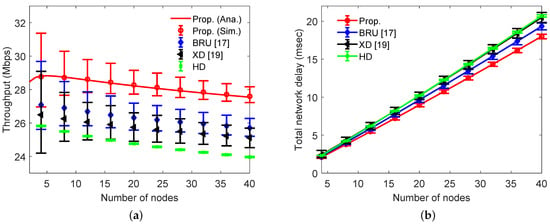
Figure 5.
Overall network performance based on the number of nodes (SIC = 110 dB) for (a) throughput and (b) delay.
5.2. Results Based on SIC
Figure 6 shows UL and DL network throughput with respect to SIC. HD performance is not related to SIC; hence, we only evaluated the FD scheme performance. SIC achieves the same level as the noise floor by eliminating self-interference at 110 dB [2]. Therefore, DL throughput increases as SIC increases. Network throughput is similar for each scheme when SIC = 80 dB. Thus, FD transmission seldom occurs due to strong residual SI. XD UL throughput is higher than other FD schemes for sufficient SIC, as shown in Figure 6a, whereas XD exhibits the lowest DL throughput, as shown in Figure 6b. Although it selects the transmission mode considering the channel capacity, the data rate is already determined by MCS, and hence, it is impossible to fully utilize the channel capacity. MAC overheads also occur, such as RTS, CTS, and ACK packets. The AP operates in HD mode for XD even if FD transmission is possible because it does not consider MAC overheads.
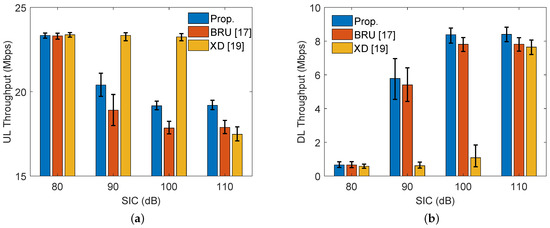
Figure 6.
Throughput based on SIC (N = 40) for (a) UL and (b) DL.
Figure 7 shows UL and DL network delay with respect to SIC. FD pair probability increases as SIC increases. Thus, the AP can transmit DL packets more frequently, which reduces DL delay significantly. The required transmission time for FD and hybrid mode is longer than for HD because two ACK packets are transmitted. Therefore, UL delay increases as FD pair probability increases.
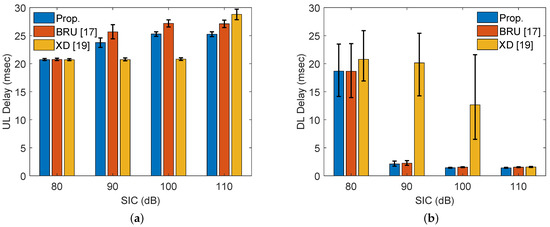
Figure 7.
Delay based on SIC (N = 40) for (a) UL and (b) DL.
Figure 8 shows the overall network performance with respect to SIC. FD transmission rarely occurs when SIC = 80 dB. The proposed algorithm obtains the gain through hybrid mode. The AP operates in hybrid mode when data can be transmitted faster than FD mode. If FD transmission rarely occurs, the proposed algorithm cannot be applied appropriately. This is the same for conventional FD schemes. Therefore, the overall network performance for the three schemes is similar. However, the proposed algorithm achieves better network performance than conventional FD schemes as SIC increases. Thus, hybrid mode can improve throughput and delay performance.

Figure 8.
Overall network performance based on SIC (N = 40) for (a) throughput and (b) delay.
Figure 9 shows MCS probability. FD transmission is almost impossible when SIC = 80 dB, and FD pair probability increases as SIC increases, with high MCS. Hybrid mode transmission time = 711 μs for the proposed simulation environment, and FD mode transmission time = 919 μs and 748 μs with MCS = 2 and 3, respectively. Thus, the AP operates in hybrid mode when MCS = 2 or 3. In contrast, the AP operates in FD mode when MCS > 4. Simulation results confirm that selecting the transmission mode with respect to the MCS level improves network throughput.
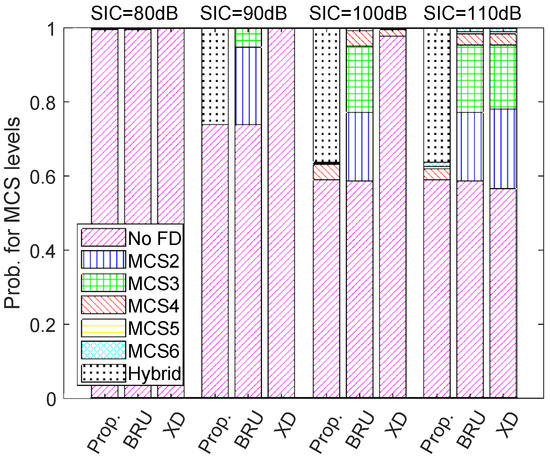
Figure 9.
MCS level probability.
6. Conclusions
This paper proposes a hybrid transmission switching algorithm to improve throughput. If the asymmetric FD pair is established, inter-node interference occurs. This leads to a low MCS level of DL transmission. In this case, using hybrid transmission, which transmits UL and DL data separately, DL transmission also can be transmitted to a higher MCS level. Therefore, the AP selects the transmission mode based on the required transmission time in the proposed algorithm. It can improve throughput even in the presence of the unused link period because the AP considers also MAC overhead.
We also design an analytical model considering FD pair probability to analyze the proposed algorithm. Although the FD pair probability is a key parameter for analyzing network performance, it has been rarely addressed. Therefore, we consider FD pair probability to improve the accuracy of our analytical model. The accuracy for the analytical model is verified by extensive simulation, with measured and simulation results confirming that the proposed algorithm can achieve better throughput than conventional FD or HD schemes by selecting the transmission mode.
In this paper, we focus on the network with only one AP. The proposed algorithm can obtain the gain by selecting the transmission mode due to the low interference environment. Therefore, we will consider a network with multiple APs in our future work.
Author Contributions
J.-K.K., W.-J.L. and J.-H.K. were the main researchers who initiated and organized the research reported in this paper, and all authors were responsible for analyzing the simulation results and writing the paper. All authors have read and agreed to the published version of the manuscript.
Funding
This work was supported by the Future Combat System Network Technology Research Center program of the Defense Acquisition Program Administration and Agency for Defense Development (UD190033ED).
Conflicts of Interest
The authors declare no conflict of interest.
References
- Choi, J.I.; Jain, M.; Srinivasan, K.; Levis, P.; Katti, S. Achieving single channel, full duplex wireless communication. In Proceedings of the Annual International Conference on Mobile Computing and Networking (ACM MobiCom), Chicago, IL, USA, 20–24 September 2010; pp. 1–12. [Google Scholar]
- Bharadia, D.; McMilin, E.; Katti, S. Full duplex radios. In Proceedings of the ACM Special Interest Group on Data Communication (SIGCOMM), Hong Kong, China, 12–16 August 2013; pp. 375–386. [Google Scholar]
- Chung, M.; Sim, M.S.; Kim, J.; Kim, D.K.; Chae, C.B. Prototyping real-time full duplex radios. IEEE Commun. Mag. 2015, 53, 56–64. [Google Scholar] [CrossRef]
- Yang, P.; Xiao, Y.; Xiao, M.; Li, S. 6G Wireless Communications: Vision and Potential Techniques. IEEE Netw. 2019, 33, 70–75. [Google Scholar] [CrossRef]
- Xin, Y.; Heberling, A.D.; Oteri, K.; Gan, M.; Tsodik, G.; Ngoc, T.L.; Shilo, S.; Liang, D.; Au, E.; Yang, R.; et al. IEEE 802.11-18/0498r6: Technical Report on Full Duplex for 802.11; Technical Report; IEEE: Waikoloa, HI, USA, 2018. [Google Scholar]
- Tang, A.; Wang, X. A-Duplex: Medium access control for efficient coexistence between full-duplex and half-duplex communications. IEEE Trans. Wirel. Commun. 2015, 14, 5871–5885. [Google Scholar] [CrossRef]
- Kim, S.; Sim, M.S.; Chae, C.B.; Choi, S. Asymmetric Simultaneous Transmit and Receive in WiFi Networks. IEEE Access 2017, 5, 14079–14094. [Google Scholar] [CrossRef]
- Kim, J.K.; Lee, W.J.; Chae, C.B.; Kim, J.H. Performance Analysis of Fair Medium Access Control Protocol for Asymmetric Full Duplex in WLAN. IEEE Access 2020, 8, 140546–140557. [Google Scholar] [CrossRef]
- Ahn, H.; Park, Y.D.; Kim, D.; Suh, Y.J. A Full-Duplex MAC Protocol Based on Buffer Status Report for Successive Full-Duplex Link Setup. IEEE Commun. Lett. 2019, 23, 1506–1509. [Google Scholar] [CrossRef]
- Chen, T.; Diakonikolas, J.; Ghaderi, J.; Zussman, G. Hybrid Scheduling in Heterogeneous Half- and Full-Duplex Wireless Networks. IEEE/ACM Trans. Netw. 2020, 28, 764–777. [Google Scholar] [CrossRef]
- Ren, Y.; Chin, K.W.; Soh, S. A Distributed Link Scheduler for In-Band Full Duplex Wireless Networks. IEEE Trans. Veh. Technol. 2020, 69, 5255–5267. [Google Scholar] [CrossRef]
- Lee, J.; Quek, T.Q.S. Hybrid Full-/Half-Duplex System Analysis in Heterogeneous Wireless Networks. IEEE Trans. Wirel. Commun. 2015, 14, 2883–2895. [Google Scholar] [CrossRef]
- Liu, S.; Fu, L.; Xie, W. Hidden-Node Problem in Full-Duplex Enabled CSMA Networks. IEEE Trans. Mob. Comput. 2020, 19, 347–361. [Google Scholar] [CrossRef]
- Murad, M.; Eltawil, A.M. Performance Analysis and Enhancements for In-Band Full-Duplex Wireless Local Area Networks. IEEE Access 2020, 8, 111636–111652. [Google Scholar] [CrossRef]
- Kim, J.K.; Kim, W.K.; Kim, J.H. A new full duplex MAC protocol to solve the asymmetric transmission time. In Proceedings of the IEEE Global Communications Conference Workshops (GC Wkshps), San Diego, CA, USA, 6–10 December 2015; pp. 1–5. [Google Scholar]
- Alim, A.; Saruwatari, S.; Watanabe, T. Asym-FDMAC: In-band full-duplex medium access control protocol for asymmetric traffic in wireless LAN. Wirel. Netw. 2020, 26, 807–822. [Google Scholar] [CrossRef]
- Ahn, H.T.; Shu, Y.J. Full-duplex MAC protocol using buffer status reports during unused uplink periods in WLAN. Ad Hoc Netw. 2019, 94, 1–11. [Google Scholar] [CrossRef]
- Li, S.; Zhou, M.; Wu, J.; Song, L.; Li, Y.; Li, H. X-duplex relaying: Adaptive antenna configuration. IEEE Commun. Lett. 2017, 21, 1083–1086. [Google Scholar] [CrossRef]
- Yao, C.; Song, L.; Li, Y. X-duplex radios: Flexible switching between full-duplex and half-duplex. IEEE Wirel. Commun. Lett. 2018, 7, 94–97. [Google Scholar] [CrossRef]
- Bianchi, G. Performance analysis of the IEEE 802.11 distributed coordination function. IEEE J. Sel. Areas Commun. 2000, 18, 535–547. [Google Scholar] [CrossRef]
- Institute of Electrical and Electronics Engineers. IEEE Standard for Information Technology-Telecommunications and Information Exchange Between Systems Local and Metropolitan Networks-Specific Requirements, Part 11: Wireless LAN Medium Access Control (MAC) and Physical Layer (PHY) Specifications; IEEE: Piscataway, NJ, USA, 2016. [Google Scholar]
- Lee, J.; Kim, W.; Lee, S.J.; Jo, D.; Ryu, J.; Kwon, T.; Choi, Y. An experimental study on the capture effect in 802.11a networks. In Proceedings of the ACM International Workshop on Wireless Network Testbeds, Experimental Evaluation and CHaracterization (WiNTECH), Montreal, QC, Canada, 9–14 September 2007; pp. 19–26. [Google Scholar]
Publisher’s Note: MDPI stays neutral with regard to jurisdictional claims in published maps and institutional affiliations. |
© 2021 by the authors. Licensee MDPI, Basel, Switzerland. This article is an open access article distributed under the terms and conditions of the Creative Commons Attribution (CC BY) license (http://creativecommons.org/licenses/by/4.0/).